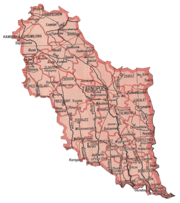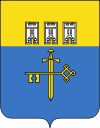Ternopil Oblast
| Ternopil Oblast Тернопільська область Ternopil’s’ka oblast’ |
|||
|---|---|---|---|
| — Oblast — | |||
|
|||
| Nickname(s): Тернопільщина (Ukrainian) Ternopilshchyna (transliteration) |
|||
 |
|||
| Country | |||
| Admin. center | Ternopil | ||
| Government | |||
| - Governor | Mykhaylo Tsymbalyuk[1] | ||
| - Oblast council | 120 seats | ||
| - Chairperson | Oleksiy Kaida[2] (Svoboda[2]) | ||
| Area | |||
| - Total | 13,823 km2 (5,337.1 sq mi) | ||
| - Land | ? km2 (Expression error: Unrecognised punctuation character "?" sq mi) | ||
| - Water | ? km2 (Expression error: Unrecognised punctuation character "?" sq mi) ?%% | ||
| Area rank | Ranked 22nd | ||
| Population (2006) | |||
| - Total | 1,107,294 | ||
| - Rank | Ranked 23rd | ||
| - Density | 80.1/km2 (207.5/sq mi) | ||
| - Annual growth | ?% | ||
| Demographics | |||
| - Average salary | UAH ? (?) | ||
| - Salary growth | ?% | ||
| Time zone | EET (UTC+2) | ||
| - Summer (DST) | EEST (UTC+3) | ||
| Postal code | ? | ||
| Area code | +380-35 | ||
| ISO 3166 code | UA-61 | ||
| Raions | 17 | ||
| Cities of oblast subordinance | 1 | ||
| Cities (total) | 14 | ||
| Towns | 17 | ||
| Villages | 1019 | ||
| FIPS 10-4 | UP22 | ||
Ternopil Oblast (Ukrainian: Тернопільська область, translit. Ternopil’s’ka oblast’; also referred to as Ternopilshchyna - Ukrainian: Тернопільщина) is an oblast (province) of Ukraine. Its administrative center is Ternopil, through which flows the Seret River, a tributary of the Dnister.
Contents |
Geography
The area of the oblast is 13,800 km². The Dnister forms the southern border with the Chernivtsi Oblast. Some of its tributaries flowing through the oblast are the Zbruch, the Seret and the Strypa Rivers. The Seret River, not to be confused with the Siret River nor the smaller Seret in Lviv Oblast, is a left tributary of the Dnister flowing through the oblast capital, i.e. Ternopil.
History
Before World War I, most the area of the oblast was ruled by Austria-Hungary, and the northern-most section ruled by Russia; after that war Poland assumed the governing of the area, as part of the Tarnopol Voivodeship (prior to World War II). As everywhere throughout Ukraine the foreign population was concentrated in the cities. During Polish times in Ternopil the majority of population was Polish, and in Soviet times—Russian. The capital population before World War II was 40% Polish, 20% Ukrainian and 40% Jewish of 35,000 counted. The oblast is associated with the national movement, due to the fact that during the Soviet and Polish interventions in 1919 the Chortkiv offensive took place to stop the occupation of the newly established West Ukrainian People's Republic and later the local population was loyal to the revolutionary UPA.

After World War II, upon Soviet annexation to the Ukrainian SSR, most Poles were relocated to Poland. The area of the former Polish Voivoideship was expanded by adding territory in the north, though the western-most parts were transferred to Lviv oblast. In 2005, the population had grown to roughly 225,000, mostly Ukrainian with a large Russian or Russian-speaking minority and an invisibly small Jewish community. The religion is mostly Eastern Rite Catholic (Uniate) with active Orthodox and Protestant minorities. Many churches, large and small, have been built every year since the collapse of the Soviet Union in 1991. The city has important institutions of higher education, including two teacher's colleges, an international medical school with instruction in English and one of three economics institutes in Ukraine.
One of the major battles in the Soviet Union was fought to control Ternopil because it is a rail transportation hub. After the war, the destroyed residential section near the river was turned into an artificial lake instead of being rebuilt.
Points of interest
The following historic-cultural sites were nominated for the Seven Wonders of Ukraine.
- Verteb cavern
- Bohyt
- The ruins of Czerwonogród
- Pochaiv Lavra
- Zavarnytsia spiritual center
- Vyshnevets Palace
- Camp UPA

- Dzhuryn Waterfall
- Ternopil Castle
- Berezhany Castle
Population
The current estimated population is 1.1 million people (as of 2004).
Economy
Although the city continues to grow rapidly, heavily supported by remittances from workers abroad, many abandoned buildings in rural areas of the oblast and even in the city give mute evidence that the economy is uneven.
Subdivisions
The Ternopil Oblast is administratively subdivided into 17 raions (districts), as well as 1 city (municipality) which is directly subordinate to the oblast government: Ternopil, the administrative center of the oblast.

| In English | In Ukrainian | Administrative Center | |
|---|---|---|---|
| Berezhanskyi Raion | Бережанський район Berezhans'kyi raion |
Berezhany (City) |
|
| Borshchivskyi Raion | Борщівський район Borshchivs'kyi raion |
Borshchiv (City) |
|
| Buchach Raion | Бучацький район Buchats'kyi raion |
Buchach (City) |
|
| Chortkiv Raion | Чортківський район Chortkivs'kyi raion |
Chortkiv (City) |
|
| Husiatyn Raion | Гусятинський район Husiatyns'kyi raion |
Husiatyn (Urban-type settlement) |
|
| Kozivskyi Raion | Козівський район Kozivs'kyi raion |
Kozova (Urban-type settlement) |
|
| Kremenetskyi Raion | Кременецький район Kremenets'kyi raion |
Kremenets (City) |
|
| Lanivtsi Raion | Лановецький район Lanovets'kyi raion |
Lanivtsi (City) |
|
| Monastyryska Raion | Монастириський район Monastyrys'kyi raion |
Monastyryska (City) |
|
| Pidhaietskyi Raion | Підгаєцький район Pidhayets'kyi raion |
Pidhaitsi (City) |
|
| Pidvolochysk Raion | Підволочиський район Pidvolochys'kyi raion |
Pidvolochysk (Urban-type settlement) |
|
| Shumsk Raion | Шумський район Shums'kyi raion |
Shumsk (City) |
|
| Terebovlya Raion | Теребовлянський район Terebovl'ans'kyi raion |
Terebovlya (City) |
|
| Ternopil Raion | Тернопільський район Ternopils'kyi raion |
Ternopil (City) |
|
| Zalishchytskyi Raion | Заліщицький район Zalishchyts'kyi raion |
Zalishchyky (City) |
|
| Zbarazkyi Raion | Збаразький район Zbaraz'kyi raion |
Zbarazh (City) |
|
| Zboriv Raion | Зборівський район Zborivs'kyi raion |
Zboriv (City) |
See also
- Subdivisions of Ukraine
- List of Canadian place names of Ukrainian origin
References
- ↑ Yanukovych dismissed his governor, Unian.net (June 17, 2010)
- ↑ 2.0 2.1 Svoboda member heads Ternopil regional council, Interfax-Ukraine (26 March 2009)
External links
|
||||||||||||||||||||
|
|||||||||||||||||

